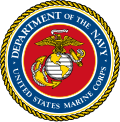| I Marine Expeditionary Force | |
|---|---|
 I MEF insignia | |
| Active | 8 November 1969 –present |
| Country | |
| Branch | |
| Type | Marine Air-Ground Task Force |
| Role | Expeditionary combat force |
| Size | 53,000 apprx. |
| Part of | U.S. Marine Forces Pacific |
| Garrison/HQ | MCB Camp Pendleton, California, U.S. |
| Engagements | |
| Commanders | |
| Current commander | LtGen Christian F. Wortman [1] |
| Notable commanders | Gen Joseph F. Dunford, Jr., Gen Anthony Zinni, Gen Michael Hagee, Gen James T. Conway, Gen James Mattis, Gen John F. Sattler |
The I Marine Expeditionary Force ("I" pronounced "One") is a Marine Air Ground Task Force (MAGTF) of the United States Marine Corps primarily composed of the 1st Marine Division, 3rd Marine Aircraft Wing, and 1st Marine Logistics Group. It is based at Marine Corps Base Camp Pendleton.
Contents
- Etymology
- Mission
- Lineage
- Structure
- Units
- Recent service
- List of commanders
- References
- External links
I Marine Expeditionary Force is the largest of the three MEFs in the Fleet Marine Force and is often referred to as the "Warfighting MEF" for its consistent involvement and contributions in major armed conflicts. It is presently commanded by Lieutenant General Michael Cederholm. The deputy commander is Brigadier General Michael R. Nakonieczny.




































